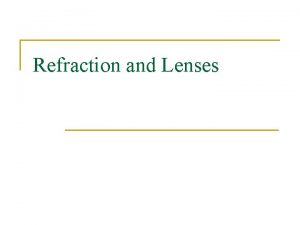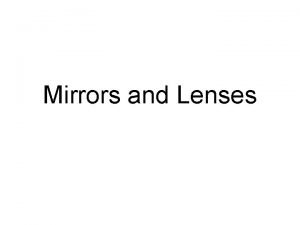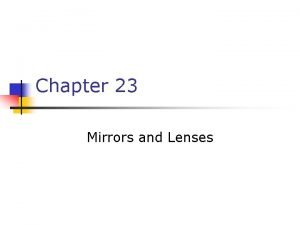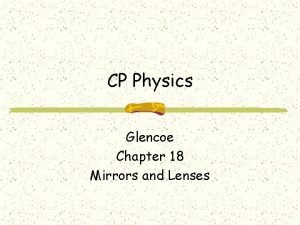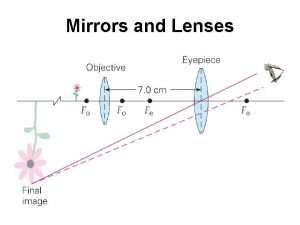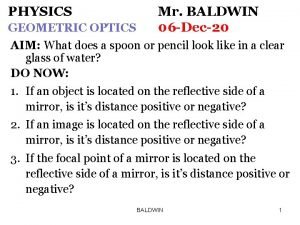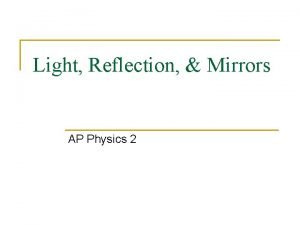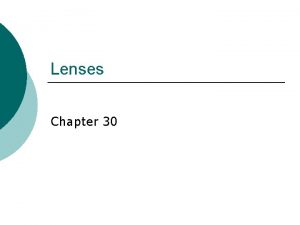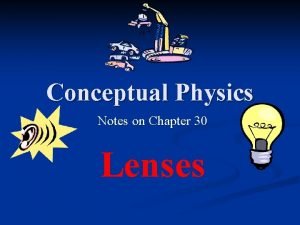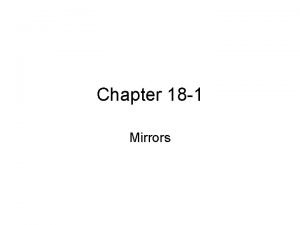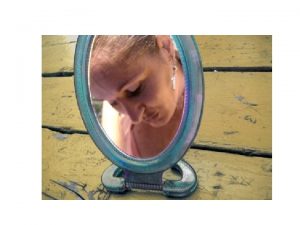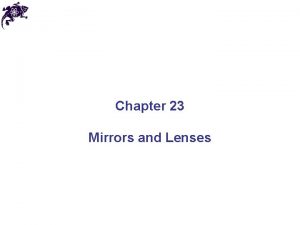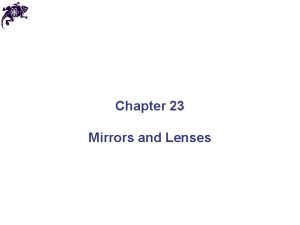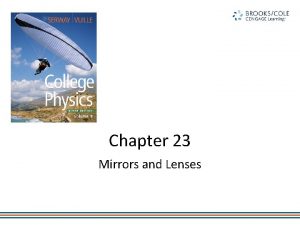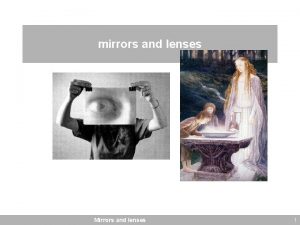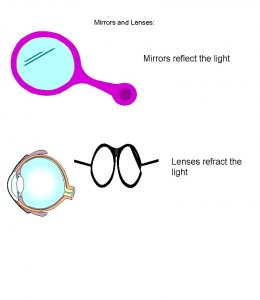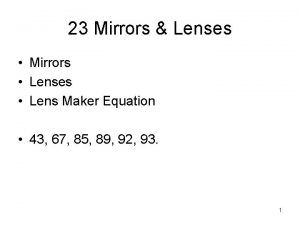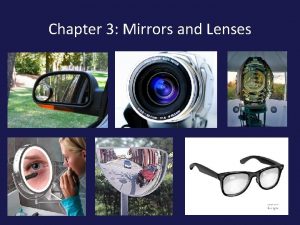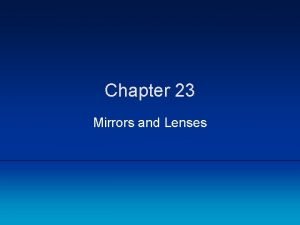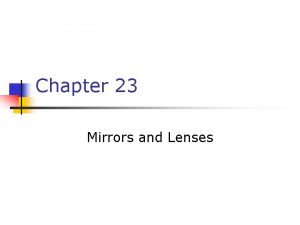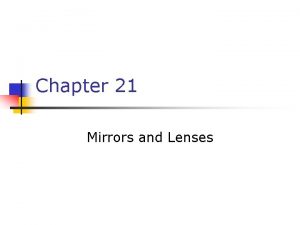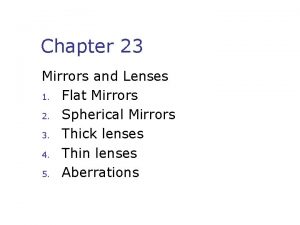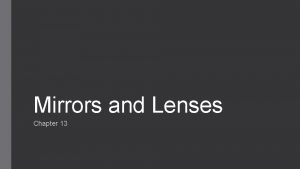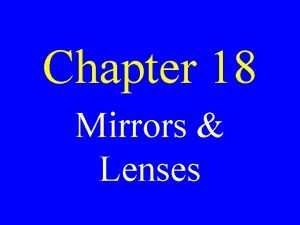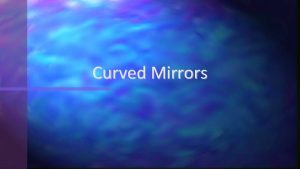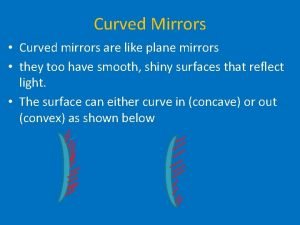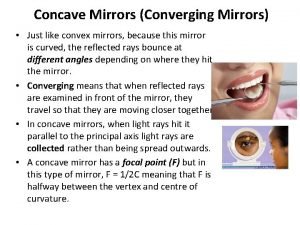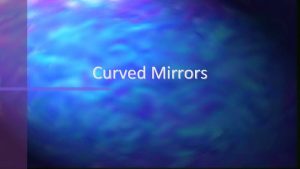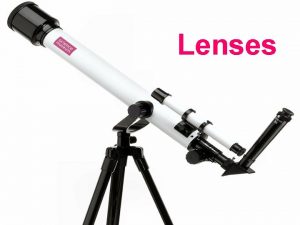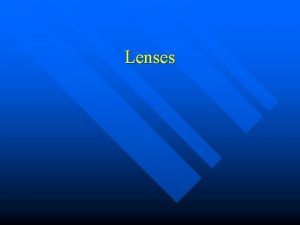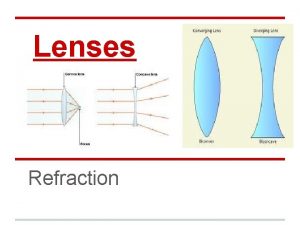Mirrors and Lenses Chapter 23 The Law of

































- Slides: 33

Mirrors and Lenses Chapter 23

The Law of Reflection • Light waves are electromagnetic waves. • Light waves travel from their source in all directions • Light is made up of rays that travel in straight lines. • An arrow, called a ray, is used to show the path and direction of light

Mirrors • Law of Reflection – states that the angle of reflection is equal to the angle of incidence. • A ray diagram shows how rays change direction when they strike mirrors and pass through lenses.

Plane Mirror (Create Image) • A mirror with a flat surface is a plane mirror. • You see a reversed (R-L) image • Rays of light strike you and reflect. They strike the mirror and are reflected into your eyes.

Plane Mirror • The image is virtual, right side up and reversed. • Virtual Image- a copy of an object formed at the location from which the light rays appear to come. (Rays do not really come from behind the mirror)

Concave Mirrors • A concave mirror is curved inward. They can produce both a virtual or a real image. • Real images are in front of the mirror • The point at which light rays meet is called the focal point.

Concave Mirror Can make small objects appear larger Ex: Make-up mirrors, shaving mirrors

Concave Mirror • Real images occur when the object is further away from the focal point. Reflected rays meet in front of the mirror. • Virtual images occur when the object is closer to the mirror than the focal point. Reflected rays spread out and appear to be coming from behind the mirror.

How do you locate the image in a Concave Mirror Pick a point on the object (usually the one furthest from the principal axis), and then draw 2 intersecting rays that obey the following rules: 1. Any ray parallel to the principal axis is reflected through the focus. 2. Any ray through the focus is reflected parallel to the principal axis. 3. Any ray through the center of curvature is reflected back along the incident ray (back along itself)

Concave Mirrors C “OUTSIDE“ the focus F Moving towards the focus, the image is REAL, inverted. It could be smaller, the same size, or larger than the image (depending on the object location)

Concave Mirrors – outside the focus

Concave Mirrors C “INSIDE” the focus F Moving towards the mirror, the image is VIRTUAL, UPRIGHT, and gets smaller (although the image is ALWAYS larger than the object itself).

Concave Mirrors – inside the focus

Convex Mirror • A convex mirror is bent outward. The object is virtual and appears smaller and upright. • Convex mirrors spread out light.

Convex Mirrors Can make large objects appear smaller (see a WIDE view) Ex: Security mirrors, driveway mirrors, car door mirrors

Convex Mirrors Note: All rays want to pass through F, but none do F C’ C F’ When an object gets closer to the mirror, its image is VIRTUAL, UPRIGHT, and keeps getting smaller (and the images are always smaller than the object).

Convex Mirrors

Refraction • The index of refraction for a material is the ratio of the speed of light in a vacuum to the speed of the light in the material. • When light enters a new medium at an angle, the change in speed causes the light to bend or refract.

Concave and Convex Lenses • Lens- an object made of a transparent material that has 1 or 2 curved surfaces that can refract light. • The curvature and the thickness affect the way it refracts light.

Concave Lens • A concave lens is curved inward at the center and the thickest part at the outside edges. • The light rays are spread out. • Smaller, upright, virtual images are always formed. The image is formed at the point from which the refracted rays appear to come


Image Formation in Concave Lenses F’ F

Concave Lenses F

Convex Lens • A convex lens is curved outward at the center and is thinnest at the outer edge. • Convex lenses form either real or virtual images. • The real image is upside down.

Convex Lenses • Real images are produced when an object is further away from the mirror than the focal point (The object is also inverted. ) • Virtual images are produced when an object is closer to the lens than the focal point. ( The object is upright and larger. )

Image Formation in Convex Lenses F’ F

Convex Lenses F F’

Type Real / Virtual Upright/ Upside-down Smaller/Larger Plane Mirror Virtual Upright (Reversed) Same Concave Mirror (Behind focal pt) Real Upside down Depends on location Concave Mirror (In front of focal pt) Virtual Upright Depends on location Convex Mirror Virtual Upright Smaller Concave Lens Virtual (b/twn focus & lens) Upright Smaller Convex Lens (Behind focal pt) Real Upside down Depends on location Convex Lens (In front of focal pt) Virtual Upright Larger

23. 2 Light & Sight The Human Eye Cornea: Protective “Window” of eye Iris: Colored part that acts like a camera shutter. Pupil: Hole in the middle of the iris. Lens: has adjustable focal length. Retina: Where image is formed. Optic nerve: Sends image to brain where it is flipped upside down. Muscles that “tense” the lens

Eye Problems • Nearsightedness • Farsightedness The eyeball is too thick, causing the thin, causing the image to focus in front image to focus behind of the retina. A person can't see distant can see distant objects, but can see objects clearly, but near objects well. A has difficulty with near concave lens can be objects. A convex used to correct this lens can be used to problem. correct this problem.

23. 3 Light and Technology Cameras …… BOTH use converging lenses with the object far beyond the focus and both form INVERTED images. Film …. . and the human eye

Magnifying Glasses 2 F’ F’ Larger, virtual image that you see Object that you are looking at (under the lens) F 2 F

Film Projectors White screen
 What is refraction in lenses
What is refraction in lenses Mirrors and lenses
Mirrors and lenses Mirrors and lenses
Mirrors and lenses Physics classroom lenses and mirrors
Physics classroom lenses and mirrors Types of mirrors and lenses
Types of mirrors and lenses Mirror sign convention
Mirror sign convention Ap physics 2 mirrors and lenses
Ap physics 2 mirrors and lenses Newton's first law and second law and third law
Newton's first law and second law and third law Si unit of newton's first law
Si unit of newton's first law Chapter 17 reflection and mirrors
Chapter 17 reflection and mirrors V=k/p
V=k/p Boyle's law charles law avogadro's law
Boyle's law charles law avogadro's law Chapter 30 lenses
Chapter 30 lenses Chapter 30 conceptual physics
Chapter 30 conceptual physics Spherical aberration in mirrors
Spherical aberration in mirrors Physics
Physics Hình ảnh bộ gõ cơ thể búng tay
Hình ảnh bộ gõ cơ thể búng tay Slidetodoc
Slidetodoc Bổ thể
Bổ thể Tỉ lệ cơ thể trẻ em
Tỉ lệ cơ thể trẻ em Voi kéo gỗ như thế nào
Voi kéo gỗ như thế nào Chụp phim tư thế worms-breton
Chụp phim tư thế worms-breton Hát lên người ơi alleluia
Hát lên người ơi alleluia Các môn thể thao bắt đầu bằng tiếng chạy
Các môn thể thao bắt đầu bằng tiếng chạy Thế nào là hệ số cao nhất
Thế nào là hệ số cao nhất Các châu lục và đại dương trên thế giới
Các châu lục và đại dương trên thế giới Công thức tính thế năng
Công thức tính thế năng Trời xanh đây là của chúng ta thể thơ
Trời xanh đây là của chúng ta thể thơ Cách giải mật thư tọa độ
Cách giải mật thư tọa độ Làm thế nào để 102-1=99
Làm thế nào để 102-1=99 độ dài liên kết
độ dài liên kết Các châu lục và đại dương trên thế giới
Các châu lục và đại dương trên thế giới Thể thơ truyền thống
Thể thơ truyền thống Quá trình desamine hóa có thể tạo ra
Quá trình desamine hóa có thể tạo ra
